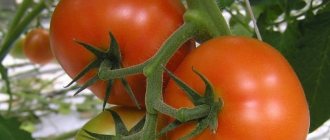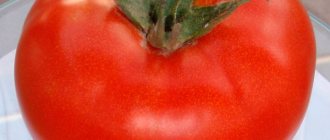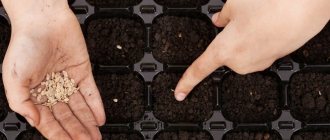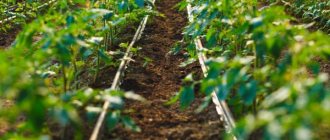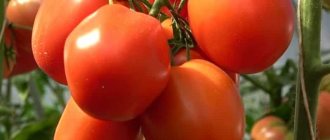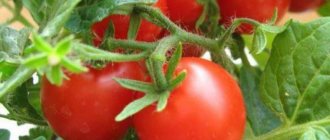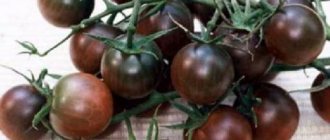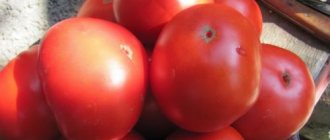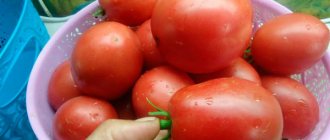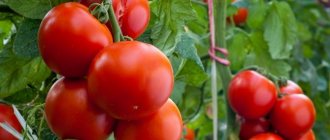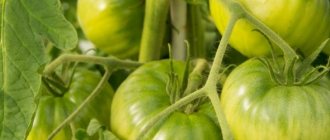In recent decades, breeders have developed many new varieties and hybrids of tomatoes. Summer residents always planted at least a bed of bushes of a new variety of tomato in their gardens. But over time, they began to grow hybrid tomatoes in their gardens, because they have improved characteristics, active fruiting, and resistance to most diseases.
One of these hybrids is the Andromeda f1 - with early ripening tomatoes.
The main characteristics of the variety and the nuances of cultivation will be discussed below. What is an F1 hybrid and GMO
Tomato Andromeda f1
History of the variety's creation
This hybrid was bred by a breeder from Rostov, A. A. Mashtakov, in the last quarter of the last century. After variety testing, this tomato was included in the State Register of Russia in 1998.
Related article:
How to grow a tomato tree in open ground and in a greenhouse
Tomato Andromeda F1 is recommended for growing in garden beds in the Central Black Earth and North Caucasus regions, in the Middle and Lower Volga, as well as in Western and Eastern Siberia. It is also successfully grown in the Moscow region and the middle zone, but in greenhouses and film greenhouses.
Collection, storage and use of crops
Tomatoes are harvested as they ripen. Overripe fruits are prone to cracking and falling. After harvesting, the vegetables are sorted, dried and stored in a cool place.
Expert opinion
Stanislav Pavlovich
Gardener with 17 years of experience and our expert
Ask a Question
Andromeda tomatoes have established themselves as a universal variety. Tomatoes are consumed raw and used for preparing vegetable dishes, sauces and juices. The fruits also make delicious pickles.
Description
Tomato Andromeda F1, photo
The variety is determinant, therefore it is limited in growth - the central shoot grows to a height of 0.7 m, when grown in garden beds, in greenhouse conditions the bushes can reach a height of 1 m. The bushes are compact, non-standard, semi-spreading. The shoots are medium leafy, the number of side shoots is average. The foliage is medium in size, elongated, slightly wrinkled, emerald green with a grayish tint.
What does determinate and indeterminate tomato varieties mean?
The first inflorescence is formed above the sixth leaf, the next ones are formed every two leaves. The inflorescences are racemose, each of them can produce up to 6-7 fruits.
Related article:
To prevent tomatoes from becoming fattened with greens: 5 tricks
The tomato is an early ripening tomato; the harvest can be harvested within 90-105 days after germination of the seed material. But the harvest of pink Andromeda ripens a little earlier - less than 3 months.
There are several varieties of this hybrid, which differ in the color and color of the fruit: red, pink or yellow.
Tomato Golden Andromeda
The fruits are round in shape, slightly flattened below, medium in size, with slightly noticeable ribbing. The weight of the fruit can be 80-120 g for pink Andromeda, up to 320 g for Golden Andromeda, each tomato has 4-5 seed chambers with an average amount of liquid. The skin is compacted, medium thickness, smooth, bright red in color.
The taste of ripe tomatoes is sour-sweet, taster rating is 4.5 points out of 5.
The keeping quality of the fruits is good, they can easily be transported over long distances, and they can be stored for quite a long time in the refrigerator.
Varietal characteristics
- Refers to hybrid species that have a number of positive qualities.
- The tomato has early ripening periods. To get the first harvests, you need to wait only 92 to 115 days. If you take the golden variety of the variety, it ripens in about 104-110 days. The pink variety will bear fruit very early - in just 77-89 days. If the season turns out to be cloudy, cold and rainy, then the dates may shift by 5-10 days.
- All three types of culture are determinant. The bush is not distinguished by dense branches, does not form a trunk, and is semi-spreading. Its height is 55-70 cm. If the variety is grown indoors, the stem can grow more than a meter.
- One brush can form up to 7 tomatoes.
- If we talk about the color of the leaves, then only in the pink type they have a slight silvery tint, while other types are standard light green.
- The variety is cold-resistant. It is perfectly stored for up to 120 days in certain conditions, where it can ripen.
- All types are very juicy, tasty, aromatic. Their skin is smooth and dense, the number of chambers is 4-5. Tomato "Andromeda" has excellent reviews. Photos show all types.
- Productivity. The red fruits weigh up to 130 grams. Productivity is more than 10 kg per square meter. Pink fruits will weigh 150 grams. The yield will be slightly less or the same. The most outstanding fruits are produced by the golden Andromeda species, where the weight of tomatoes can reach 320 grams.
- All subspecies have a universal table purpose, can be used for preparing any preserves and eaten fresh. Nutritional value is high.
Diseases and pests
According to experts, the Andromeda F1 tomato is characterized by fairly high resistance to major diseases. However, under unfavorable conditions it can be affected by late blight, blossom end rot and some other fungal diseases.
Andromeda rosea seeds F1
To prevent the development of diseases on this tomato, it is necessary to follow the rules of crop rotation and not plant a tomato in the place where carrots, beets or cucumbers previously grew. Watering is carried out with warm water in the early morning or evening, and it is necessary to water the plants at the roots so that drops of moisture do not fall on the foliage. In damp times, tomatoes are not watered at all, only the root zone is loosened. You should also regularly feed tomato bushes with fertilizers containing phosphorus and potassium to strengthen the plants' immunity.
Related article:
Prohibition" for tomatoes (Kazarin method)
If the tomato bushes do become sick, they will have to be treated with appropriate fungicides; you can also use Bordeaux mixture or copper sulfate solution for spraying.
Advantages and disadvantages, features
In the years of its appearance, Andromeda could be considered a very good tomato. Now this is far from the case: breeding has greatly advanced, many modern varieties and hybrids are crowding out old, proven tomatoes from shelves and gardens. At the same time, Andromeda has not lost its importance to this day as one of the tomatoes intended for large agricultural enterprises. Of course, summer residents also plant it, but every year they look more and more closely at new products.
Among the advantages of the Andromeda F1 tomato are:
- early ripening of the crop;
- high resistance to cold, heat and unexpected temperature changes;
- unpretentiousness in cultivation;
- friendly ripening of tomatoes within the fruit cluster;
- good transportability of the crop and a long shelf life when fresh.
The hybrid, in addition to its not-so-excellent taste, has other disadvantages, for example:
- insufficiently powerful root system, requiring timely feeding;
- susceptibility of plants to late blight disease.
In some regions, this tomato, despite the recommendations of the State Register, is grown in protected soil. This does not always save you from late blight, but at least the gardener himself can regulate the temperature and humidity levels in the room, ventilate it in a timely manner and water the plants only as needed. But in order to grow a decent harvest in a greenhouse, you need to be constantly present on the site; For those summer residents who visit the garden only on weekends, this option is not suitable.
Comparison of Andromeda with similar varieties
There are a lot of varieties and hybrids of tomatoes similar to Andromeda, depending on what parameter you focus on. Apparently, the main thing in the characteristics of the hybrid is that it is intended mainly for commercial production, and not for small subsidiary plots. Oddly enough, there are not so many such varieties at all: they occupy about a tenth of the list of available varieties and hybrids of tomatoes. Among them there are pickling, salad, and universal varieties.
- A typical representative of industrial tomato varieties is the old Volgogradsky 5/95, grown since 1953. It is distinguished by very high yields, its fruits are tasty, but it is zoned only in two warm regions.
- The old Belarusian variety Peremoga is also quite good.
- It probably shouldn’t be considered strange that nowadays industrial varieties appear very rarely: breeding science has taken the direction of meeting the needs of small farms and summer residents. Industrial varieties and hybrids now mainly come to us from abroad. This is, for example, Hines or Fanter.
- Among the domestic developments of recent years, one can only mention Timur or Rozopam. The latter variety is in many ways reminiscent of Andromeda, but it is noted that its fruits are more tasty. However, the variety is zoned only in the North Caucasus. The same can be said about the high-yielding variety Lyubimets of Krasnodar.
Thus, the Andromeda tomato, which was once on the list of the best hybrids, can now hardly be recommended for widespread use in summer cottages: for these purposes it is better to choose other options . At the same time, as an industrial tomato, thanks to its high yield and good other characteristics, Andromeda can well be considered a good hybrid.
Video: Andromeda tomato harvest on the bushes
Advantages
The main advantages of the variety include:
- early fruit ripening;
- The tomato is resistant to frost and tolerates sudden temperature fluctuations;
- good taste of ripe tomatoes;
- It does not require special care.
Among the disadvantages of this hybrid, it should be noted that the roots of the tomato are poorly developed. You also need to remember that this tomato is a hybrid, so it will not be possible to collect seeds from plants - they will need to be purchased every year in specialized stores.
Landing
This tomato is not capricious, you just need to follow all the rules when growing seedlings, transplanting seedlings into open ground and provide normal care in the future, then the tomatoes will delight you with good fruiting.
Related article:
Growing tomato seedlings in milk
Characteristics and description of the Andromeda tomato
Andromeda tomatoes are adapted for growing in various weather conditions and can easily tolerate temperature changes, high humidity and heat.
Important! Andromeda tomatoes have received high natural immunity to fungal, viral and bacterial infections, and are rarely attacked by harmful insects.
Bush size
Depending on the growing method, the size of vegetable bushes may vary. If in open ground the maximum plant height reaches 75 centimeters, then in greenhouse complexes tomatoes grow up to 1 meter.
Fruiting and productivity
Depending on the varietal variety, vegetables ripen after 2.5 or 3.5 months of active growth and development. From one plant you get up to 12 kilograms of ripe fruits weighing from 100 to 300 grams, with excellent taste. The skin of vegetables, depending on the variety, is red, golden or pink.
How to grow seedlings
This tomato is classified as an early-ripening variety, so seedlings can be planted in mid-March. It should be taken into account that the seeds germinate in about a week, and seedlings need to be planted in a permanent place at the age of about 2 months. Based on this, the time for planting seeds for seedlings is calculated.
Tomato seedlings Andromeda F1
The seeds are planted in rows of purchased soil, covered with a thin layer of soil, the soil is sprayed with a spray bottle, and the top is covered with glass or polyethylene. After this, the containers are placed in a warm, dark place until the seeds germinate.
After about a week, the first shoots appear. After this, the film or glass can be removed, and the seedlings should be transferred to the windowsill.
Further care of the seedlings consists of regular watering, adding a couple of subbarks while growing the seedlings, and picking in separate cups.
Related article:
What fertilizers do tomatoes lack?
Tomato seedlings should be picked at the stage of a pair of two true leaves. Approximately 10-12 days after this procedure, you can feed the young plants for the first time. Use urea or other fertilizer as a top dressing. Containing nitrogen. The second feeding can be done a couple of weeks after the first.
A couple of weeks before transplanting, the seedlings begin to harden off. To do this, they are taken out into the fresh air - first for half an hour, but gradually increase the time spent on the street.
Characteristic
The characteristics and description of the Golden Andromeda tomato variety gives a general idea of the plant, which can be supplemented exclusively by practical experience in growing the crop. The general characteristics of the Andromeda Golden F1 tomato are as follows:
- The timing of sowing depends on the growing zone. With early sowing and short daylight hours, additional lighting is necessary. The shoots are friendly, which is typical for most hybrids.
- After picking and hardening, the Andromeda tomato variety in the three-leaf phase is planted in a permanent place in open or closed ground, 4 plants per 1 m2.
- In cold regions, the plant is grown in one stem; in the southern regions, you can leave 2-3 to get a more abundant harvest.
Important! If the plant is formed into several stems, then the distance between the bushes must be increased to allow access to light and good ventilation.
- This crop needs to be planted and tied only indoors. When growing “outdoors” this is not necessary, since the bush does not grow large.
- Complete feeding is required throughout the growing season.
- The Golden Andromeda tomato is undemanding to watering and can easily tolerate temperature fluctuations. It has average immunity, is not resistant to late blight, and is resistant to tobacco mosaic virus. May be affected by other diseases of nightshade crops.
Characterizing the Andromeda F1 tomato, it should be noted that it is unpretentious in care and has high cold resistance. Resistance to a number of diseases characteristic of this family is also important. According to reviews, the Golden Andromeda F1 tomato has unique properties and does not require much effort when growing.
Advantages and disadvantages
When describing Andromeda tomatoes, their advantages should be noted:
- good taste: sweet with slight sourness;
- early harvest;
- resistance to cool weather conditions;
- the ability to harvest with tassels;
- low maintenance requirements.
Culture also has some disadvantages:
- weak root system that does not grow well;
- insufficient resistance to certain diseases;
- in the northern regions it is grown in greenhouses;
Method of use
The yellow tomato variety Andromeda F1 is transportable and stores well. In wooden boxes and packed in paper, a tomato can last from 30 to 120 days. It is good both fresh and canned. Tomatoes are pickled, salted, made into juices, pastes and other types of preparations. They are an excellent addition to salads, mousses, cocktails and pizzas. They are used to prepare dishes with eggs, eggplants and meat.
Comment! Tomatoes are not high-calorie foods. Only 20 kcal is contained in 100 g of fruit. It has high nutritional value because it contains many substances important for the body.
Transplantation to a permanent place
Grown seedlings need to be transplanted into garden beds when the spring frosts have passed - depending on the growing region, from mid-May to the first ten days of June.
Planting holes are prepared in advance, but it must be taken into account that more than 4 plants should not be planted on one square. And the row spacing should be at least 0.7 m.
Related article:
Growing different varieties of tomatoes
When preparing the beds, you should add humus or compost to the soil at the rate of 6 kg per square of area and dig up the soil and incorporate organic matter.
30 g of phosphate and potassium fertilizer should be poured into the bottom of each hole. Seedlings are transplanted into holes using the transshipment method - together with a lump of earth. In this case, the root system of the tomatoes will not be damaged, and the plants will quickly acclimatize to the new location.
Further care
When growing this hybrid in the southern regions, you do not need to carry out the pinching procedure. But in colder areas, excess shoots are removed from the bushes, and the bushes themselves are tied to strong supports so that the beds with tomatoes do not turn into an overgrown plantation.
Attention: it is recommended to form the bushes of this tomato into no more than 2 stems.
You should also remove not only all emerging stepsons from the plants, but also tear off all the foliage up to the first inflorescence. But you should not pick off more than 3 leaves a day so that the bushes do not slow down their growth.
Related article:
Why does a “black leg” appear in tomato seedlings and what can be done
Planting and care
Since “Andromeda” F1 is a hybrid tomato, its main characteristics are preserved only in the first generation. Therefore, seeds are purchased anew every year before sowing. It is advisable to do this through trusted companies.
Growing seedlings
Future productivity depends on compliance with planting dates. The tomato is sown in small containers with prepared, pre-moistened soil. The sowing period is from the second half of February to mid-March. If the temperature and humidity conditions are maintained, the first shoots will appear in about a week.
If soil brought from the garden is used for seedlings, it must be disinfected before use. Harmful microorganisms living in garden soil can cause the death of sprouts.
To obtain strong seedlings, you need to create a special microclimate:
- daytime temperature - from 18 to 25°C, night temperature - about 15°C;
- do not allow the air to dry out;
- per day, young seedlings should receive lighting for 16 hours in a row;
- if the day is short, it is necessary to highlight the sprouts with special lamps.
Tomatoes are watered for the first time immediately after germination. The second - in a week or a little later. Along with watering, you can add a little organic fertilizer. Seedlings should be picked when 2-3 pairs of true leaves appear. After this procedure, every two weeks the tomatoes are fed with organic matter or complex fertilizers.
Tomato care
The hybrid is planted in the main place from late May to mid-June. During this period, slight frosts still occur in some places, so it is better to build a simple temporary shelter from film or non-woven material in advance.
With the beginning of flowering, the lower part of the stem becomes overgrown with small tubercles. If the stem is sprinkled with earth, the tubercles will turn into roots. A strengthened root system will deliver more nutrients to the plant, which will have a positive effect on the harvest.
To prevent the weak root system from drying out, the soil under the tomatoes should be covered with hay or straw - mulched.
A medium-sized plant needs to be tied to trellises and formed, in which all stepsons below the first ovary are removed. Above, leave from two to 4 stems, each of which will contain no more than 6 brushes.
Watering tomatoes
Tomatoes really don’t like too much water, as well as its absence for a long time. Regular watering is important for tomatoes. It is necessary to water only at the root with warm water; cold water reduces the air temperature near the tomato, which somewhat delays development. The sprinkling method will not work here.
If it is too humid outside or it rains frequently, watering should be stopped completely.
The amount of water per watering should be reduced to 2-3 liters per plant. If this is not done, the tomato will devote all its energy to growing green mass to the detriment of fruiting.
During the ripening period of tomatoes, excess moisture leads to cracking. At this time, the optimal amount of water will be 4-5 liters per bush at a time.
How to fertilize tomatoes
For successful development and good fruiting, tomatoes need additional nutrition. It can be given using mineral or organic fertilizers. Fertilizing should be done at least four times per season:
- 2 weeks after disembarkation.
- after the second flower ovary appears;
- during the flowering of the third cluster;
- during the fruiting period.
When is the harvest
Since the hybrid has an early ripening period, the first fruits are harvested already in July. Fruiting occurs from July to September, but the duration depends on the region and planting method - greenhouse or open bed. The first brushes should be removed green - this stimulates the development of the rest.
Irrigation regime
This tomato likes moist soil, so water it as the top layer of soil dries out. But you should not allow moisture to stagnate in the soil, otherwise the roots of the bushes may begin to rot.
After watering, the soil is loosened, breaking up the dry crust that forms. All weeds should be removed at the same time.
In hot, dry weather, it is recommended to spray tomato foliage with a spray bottle, but this should be done in the morning or evening hours.
Pest and disease control
When grown in a greenhouse or under a film cover, ventilation is carried out regularly. You can spray the bushes with fungicide 3 weeks after planting. To protect against root rot, place 1 Glyokladin tablet in the soil near each bush.
It is forbidden to spray tomatoes with preparations during fruit formation.
To protect against pests, it is recommended to treat Golden Andromeda tomatoes with an infusion of tansy or tobacco ash. Garlic water helps a lot in the fight against spider mites. To repel butterflies and caterpillars, plants are sprayed with a decoction of wormwood.
Feeding
This tomato variety has a weak root system, so you will have to fertilize the beds regularly to get a good harvest.
The first time you need to feed the tomato bushes is when the first trusses appear on the plants. First, you should water, and then add mineral fertilizer to the soil - 1 tbsp. l. per square area. The fertilizer is scattered over the surface of the soil and then incorporated into the soil.
Related article:
5 ways to use tomato tops for all occasions
The following fertilizing is carried out at intervals of 10-12 days, alternating the application of organic matter and mineral fertilizers.
Features of cultivation
Seeds of the Andromeda tomato variety are sown for seedlings on March 1-15. Seeds are sown in special mini-greenhouses or containers. The growth stimulator Zircon, which is used to treat the seed before sowing into the ground, will help speed up the process of seed germination.
The containers are covered with film and left in a dark place until the first shoots appear. Then the film is removed, and the boxes with seedlings are transferred to a well-lit place, the main thing is that there are no drafts and the seedlings are not exposed to direct sunlight.
After 1-2 true leaves appear on the plant, the seedlings are planted in separate cups.
The seedlings are transferred to open ground in May, when the ground has completely warmed up. It is important that the air temperature stays between 17-21°C. Planting scheme: 4 bushes per 1 sq. m. When planted in regions that are suitable for growing this variety, the bushes do not require pinching. In other regions with colder climates, these tomatoes are planted in greenhouses; the bushes must be pinched and tied to supports or trellises.
Due to a poorly developed root system, the bush cannot provide all its ovaries with the necessary microelements and nutrients. To do this, you need to regularly feed the plant. The first time fertilizer is applied during the formation of the first brush.
Important! For 1 sq. m of plantings contribute no more than 30 grams. fertilizing
Used as fertilizer:
- Organic.
- Iodine.
- Yeast.
- Ammonia.
- Ash.
- Hydrogen peroxide.
- Boric acid.
First, the bushes are watered well with warm water, then fertilizers are applied.
More information about growing tomatoes is described in the article: Technology of growing tomatoes. Secrets of planting and care
You might be interested in: How to properly plant tomatoes in a greenhouse: bush formation diagram, care features, photos and videos
Useful information: How to properly tie tomatoes in open ground: the best methods, step-by-step photo and video instructions
